
J A Z Z P A L —
A Web Companion to Thinking Jazz
Please remember: In synch with the ethos of the web, the list below is always in the making. Please let us know if you've made new discoveries as you make your excursions into cyberia, and please check out related web pages on this site as well.
Note as well that, while many web sites may be informative and useful, they are typically no substitute for the more sustained scholarly discussion of a book.
TO BE UPDATED AND EXPANDED PERIODICALLY—please stay tuned! Please consult CAL PAL (Contemporary American Literature Pal) and MAL PAL (Modern American Literature Pal) as well, as the dividing membrane between modern and contemporary/postmodern literature/culture/theory is, much in the spirit of postmodern forms of destabilization, fluid and permeable.
ARTS & CULTURE
- Visual Arts in Harlem Renaissance, Aaron Douglas, Palmer Hayden, Archibald Motley, Augusta Savage, and others
- HR -- American Literature and Art I, African American Art -- HR
- Who Were the Harlem Hellfighters?
- "Wild Ones," on improvisation in Marlon Brando, Charlie Parker, and Jackson Pollock (Jonathan Jones, Guardian Unlimited)
- Artcyclopedia: Fine Arts Search Engine
- John Held & the Jazz Age I, II
- Jazz Age Advertising I, II, III
- Teaching the American 20s
- Music of Freedom: Jazz Through the Lenses of Herman Leonard (BYI-MOA)
- Black Artists and the March into the Museum
JAZZ IN JUNCTION CITY
- Red Nichols I, II; Red Nichols/The Five Pennies, FP II: Battle Hymn, FP III: Troublesome Trumpet, FP IV: When the Saints, Five Pennies (full movie)
- The Brian Sisters
- Joe McQueen I, II, III, IV
Given the quasi-/pseudo-documentary nature of many feature films, and the fact that well known musicians frequently play themselves or other jazz greats, the line between feature and documentary film, already fine, blurs even more. Below please find thumbnail sketches on some few documentaries and early 20th-century feature films, which we have in Stewart Library. Please consult the Imdb and other ever-growing databases on the web.
| DOCUMENTARIES & BIOPICS
"The Gene Krupa Story" (1959) | |
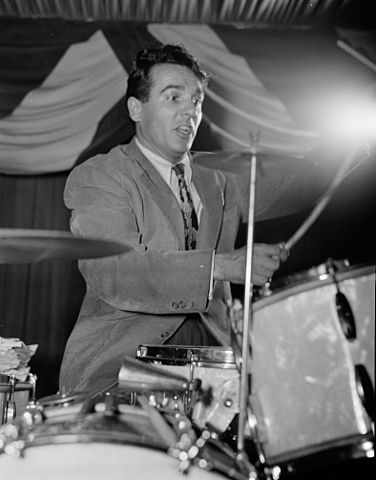 Gene Krupa |
Considered one of the greatest jazz drummers of all time and the trademark percussionist of the Benny Goodman Quartet, Krupa was the first jazz musician to become a matinee idol
inspiring the kind of popular devotion that Frank Sinatra and Elvis Presley would enjoy in later decades. The film traces (Hollywood style) Krupa's life story beginning in
1927 Chicago, when young Gene (Sal Mineo) gets his first drum set and, defying the wishes of his immigrant parents to become a priest, commits himself to a different form of worship:
drums & sticks. After a failed attempt at Catholic seminary, he sets out for New York with his high school buddy and the Julliard hopeful, Ethel, where his stunning talents win him
quick access to the big band scene and the likes of Bix Beiderbecke, Jack Teagarden, the Dorsey brothers, Buddy Lester, and others. As with other Hollywood remakes
(notably Young Man with a Horn) Gene has to choose between a good and a bad angel, and he chooses badly—at first. He slides into the jazz drug subculture, gets jailed in California,
and sabotages his career. After numerous stints with several third-rate back country bands, Ethel (you guessed it: the good angel) comes to the rescue again, and he recuperates and is
given a second chance in the world of jazz. The drum solos are recorded by Krupa himself. |
| "The Five Pennies" (1959) | |
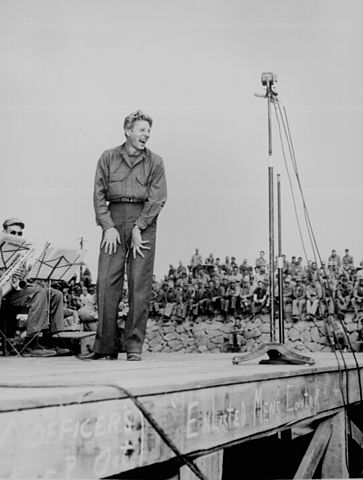 Danny Kaye |
Loring "Red" Nichols (Danny Kaye) is a cornet-playing country boy from, yes, Ogden, Utah, who goes to New York in the 1920s full of musical ambition and principles. He plays in Wil Paradise's
band and gets a whiff of New York nightlife. A speakeasy becomes his first encounter not just with mooch—they serve 90 proof in tea cups—but also with Louis Armstrong, about whom he says:
"Next to my father [a Professor of Music at Weber Academy], this is the greatest trumpet player I've heard my whole life." Eventually, pursuing his dream of playing Dixieland jazz,
he forms the "Five Pennies" which features his wife, Bobbie Meredith, as "society chanteuse." At the peak of his fame, Red and Bobbie's daughter, Dorothy, develops polio. Red quits the on-the-road
music business to move to Los Angeles where the climate is better for Dorothy and where he finds employment as a dock worker. As Dorothy becomes a teen, she learns of her father's musical past,
and he is persuaded to open a small nightclub which is failing until some names from his past, among them, Glenn Miller and Jimmy Dorsey, come to help out. — Truly, Red played with them all,
including Louis Armstrong, Jack Teagarden, and Gene Krupa . . . . The clowning between Louis and Red is superb; a must see for all Utah jazz fans!. |
| "The Jazz Age" (1956) | |
 Jazz Age |
This idiosyncratic documentary describes the
cliched spirit of "The Roaring Twenties" by showing clips from newsreels and by presenting music of the period.
Paul Whitman and George Gershwin, however, important as they are, are just a tiny (and mainstreamed) glimpse of what jazz age-music has to offer, and more is left out than put in.
The film attempts to portray, from a historical perspective, life in the United States: from the signing of the Treaty at Versailles to the Black Friday stock market crash,
in the process emphasizing American Isolationism, the Red Scare, Women's Suffrage, the "noble Experiment" of Prohibition, flapper culture and Freudian thinking, as well as the
Americans infatuation with Paris and Lindbergh's transatlantic flight. Narrated by the ever witty Fred Allen. |
| Bix — "Ain't None of Them Play Like Him Yet" (1981) Louis Armstrong |
|
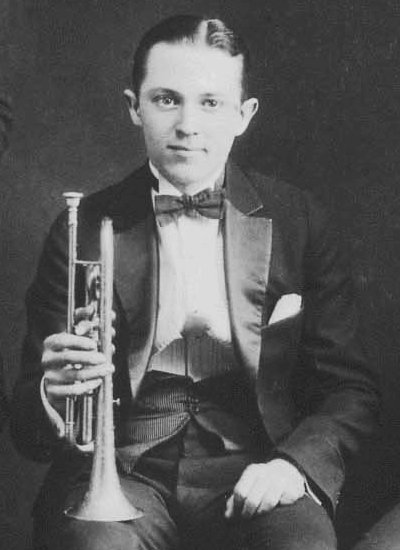 Bix Beiderbecke |
Bix chronicles the life and career of legendary jazz musician Leon Bix Beiderbecke, from his early beginnings as a child prodigy (on the piano) in Davenport, Iowa, to his tragic death at age 28 in New York City. Beiderbecke is commonly considered the great contemporary to Louis Armstrong, with both developing their styles at the same historical moment. Beiderbecke, in fact, made his first groundbreaking recordings twenty-one months before Armstrong cut his first sides with the Hot Five. By some estimates, Beider- becke's "harmonic knowledge made him the most intellectually challenging musician of his era" (Digby Fairweather). Plagued by his family's disapproval, alcoholism, and changing musical times, he became the first high-profile romantic hero of Jazz music. — This documentary features rare interviews with Louis Armstrong, Hoagy Carmichael (who is also featured in the 1950 Hollywood remake Young Man With a Horn), Doc Cheatham, Artie Shaw, and many more. |
| "Wild Women Don't Have The Blues" (1989) |
|
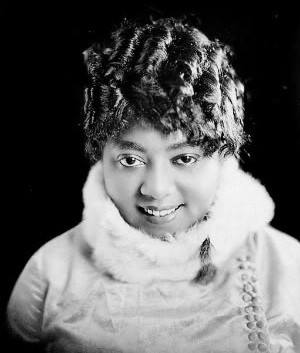 Mamie Smith |
The film shows how the blues were born out of the economic and social transformation of African American life early in the 20th century.
It recaptures the lives and times of Ma Rainey, Bessie Smith, Ida Cox, Alberta Hunter, Ethel Waters and the other legendary women who made the blues a vital part of American culture.
The film brings together for the first time dozens of rare, classic renditions of the early blues and chronicles how the blues can be traced back to the work songs of generations of Black field hands.
It also shows how the blues performers provided cultural continuity for millions of blacks who migrated from the rural South to the industrial cities of the North during World War I.
Mamie Smith broke new ground in the 1920s when she shouted out "Crazy Blues"---the first blues recording by a a black woman and one that opened up the recording industry to black artists.
Bessie Smith brought black music to a national audience in the groundbreaking early "talkie" St. Louis Blues. |
| "Jazz" (2001, PBS) | |
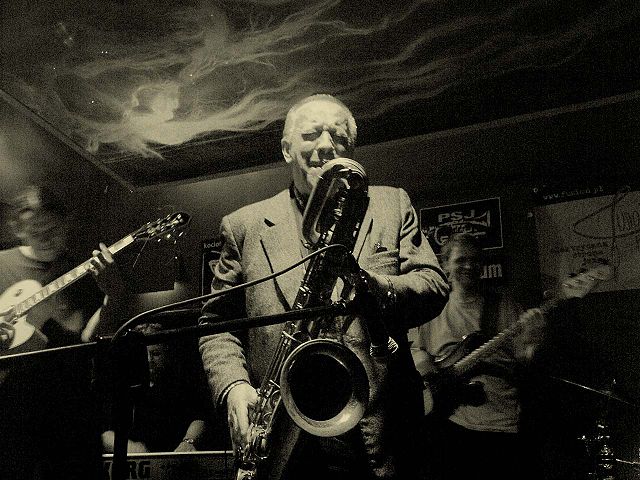 |
The early jazz players travel the country in the years before World War I, but few people have a chance to hear this new
music until 1917, when a group of white musicians from New Orleans arrives in New York to make the first jazz recording. They call themselves the
Original Dixieland Jazz Band,
and within weeks their record becomes an unexpected smash hit. Americans are suddenly jazz crazy, and the Jazz Age is about to begin. Episode 1: "Gumbo"---Beginnings to 1917: JAZZ begins in New Orleans, nineteenth century America's most cosmopolitan city, where the sound of marching bands, Italian opera, Caribbean rhythms, and minstrel shows fills the streets with a richly diverse musical culture. Here, in the 1890s, African-American musicians create a new music out of these ingredients by mixing in ragtime syncopations and the soulful feeling of the blues. Soon after the start of the new century, people are calling it jazz. In episode 1, meet the pioneers of this revolutionary art form: the half-mad cornetist Buddy Bolden (picture), who may have been the first man to play jazz; pianist Jelly Roll Morton, who claimed to have invented jazz but really was the first to write the new music down; Sidney Bechet, a clarinet prodigy whose fiery sound matched his explosive personality; and Freddie Keppard, a trumpet virtuoso who turned down a chance to win national fame for fear that others would steal the secrets of his art. |
FEATURE FILMS (select)
The Jazz Singer (1927), film on you tube
Warner Bros.' and director Alan Crosland's The Jazz Singer (1927) is an historic milestone film and cinematic landmark. (Most people associate this film with the advent of sound pictures, although Don Juan (1926), a John Barrymore silent film, also had a synchronized score and sound effects.) The wildly successful "photo-dramatic production" was based upon Samson Raphaelson's 1921 short story "The Day of Atonement" (also the basis for Raphaelson's popular 1926 Broadway play of the same name), and adapted for the screen by Alfred A. Cohn. In 1926, Warners' risky investment of a half million dollars with Western Electric in the Vitaphone sound system brought profits of $3.5 million at the box-office with this landmark talkie. It was a huge success, responsible for transforming Warners into Hollywood's hottest film factory.
Birth of the Blues (1941)
In this fun-filled film masquerading as musical history, Bing Crosby founds the first white Dixieland band. Borrowing hot licks from black musicians that could easily be understood as comment on jazz's beginning transformation from lowbrow folk tune to high art (Eddie "Rochester" Anderson comments, "Our music sure has gone highbrow"), Bing and his players struggle to invade the straight-laced clubs, succeeding only after songbird Mary Martin joins the band. Martin, in one of her infrequent movie appearances, has fun with Der Bingle jazzing up "Wait Till the Sun Shines, Nellie," a highlight of this breezily enjoyable nonsense.
Stormy Weather (1943)
Dancing great Bill "Williamson" sees his face on the cover of Theatre World magazine and reminisces: just back from World War I, he meets lovely singer Selina Rogers at a soldiers' ball and promises to come back to her when he "gets to be somebody." Years go by, and Bill and Selina's rising careers intersect only briefly, since Selina is unwilling to "settle down." Will she ever change her mind? — Full of jazz greats, the film briefly (and perhaps unwittingly?) retraces some interesting facets of the history of jazz music, such as James Reese Europe's return from Europe with the 369th Regiment Military Band (the "Harlem Hellfighters"), 'Bojangles' Robinson's light-footed dancing to some jazzy tunes on a Mississippi Riverboat, Fats Waller's virtuosity (and antics) on the piano, and a concluding big band jazzaganza with Cab Calloway, among others.
New Orleans (1947)
Music's greatest legends re-eact a Hollywood version of the birth of jazz in this resounding tribute to the town where much of it began: New Orleans. Suave Nick Duquesne
(Arturo De Cordova) is the king of Storyville/ Bourbon Street whose gambling club provides the mythic stomping grounds for Louis Armstrong and his band, as well as his bluesy sweetheart Endie
(Billie Holiday). As newly arrived debutante Miralee (Dorothy Patrick) falls for both the music and for Nick, we get interesting glimpses into the cultural geography of Storyville and the French Quarter,
into the boundary oscillations between high and low art (opera and jazz), Miralee's own dream of mingling jazz and classical music, and the gambler's transformation into a jazz promoter in Chicago and
New York. — Contrasting the squalor of Storyville with the genteel parlor music played in "respectable" casinos, the film is noteworthy for its lack of ostensible racial stereotypes and high
caliber musical performances, including several songs by Holiday, gigs by Satchmo's band, and, late in the film, Woody Herman and his orchestra.
The DVD version features additional period shorts showcasing Armstrong in "A Rhapsody in Black and Blue" (1932) and Holiday (and Duke Ellington) in "Symphony in Black" (1935); it also includes a
insightful essay on the making of New Orleans, which originated as a project for Orson Welles.
Young Man With a Horn (1950)
To see in Rick Martin (Kirk Douglas) an impersonation of cornet genius Bix Beiderbecke, as is commonly claimed, is even by Hollywood standards a fantastic stretch. Yes, Douglas plays a gifted musician who lives for his music and who fetishizes his rather phallic trumpet, and his life at the end unspins toward total dissipation, but unlike Bix, who never got married and who died from an oral fixation of a different sort—the bottle—our hero miraculously recuperates under the guiding hand of the friend and the woman whom he should have recognized as his guardian angel all along. — Hollywood mythology aside, Michael Curtiz's film has pretensions to be a art film with numerous witty repartees between Rick and the women hovering around him. "There is something about jazz that releases inhibitions. It's a sort of cheap mass produced narcotic," Rick's nemesis, wannabe psychiatrist, and short-time wife Amy North (Lauren Bacall) explains, and Rick, struck as he is by such (over) intellectualizing, is never short of a, however fumbling, answer. Flush with psychoanalytic overtones, an interesting musical score, and numerous (admittedly slender) insights about jazz, Young Man With a Horn is worth seeing, after all. While Beiderbecke may have provided the cliche of the self-destructive genius for this film—the film is based on Dorothy Baker's 1938 novel of the same title---the storytelling frame of Beiderbecke's real-life friend and biographer Hoagy Carchmichael gives it still a touch of biographical authenticity. There is more than meets the eye—at least at first glance.
Pete Kelly's Blues (1955)
In 1919, returning soldier Pete Kelly wins a cornet in a crap game. By 1927, he has a small jazz band playing in a Kansas City speakeasy. Gangster Fran McCarg wants extortion money from Pete; hot flapper Ivy Conrad wants Pete in person; but Pete just wants to keep the band together. Against a background of Dixieland jazz, pervasive corruption and angst may finally force Pete to take action.
Paris Blues (1961)
Paul Newman plays swaggering American jazz musician Ram Bowen (a corruption of Rimbaud, the cult figure of many Beat poets?) in beat-era Paris. Jamming with saxophonist Eddie (Sidney Poitier) in a downstairs nightclub, Ram lives only for his music until a pair of young American women come for a visit. Ram finds his self-absorption temporarily compromised, but while Eddie decides to return to the States, Ram at the last minute decides against bourgeouis domesticity and in favor of his musical vision in the city that has always exerted a charm on jazz musicians.—Despite a cameo appearance by Louis Armstrong, an Oscar-nominated score by Duke Ellington, and brief trombone passages by Newman himself (Newman had studied with Benny Goodman's former trombonist Murray McEacherman), I found the film flat. It reproduces the stereotype of the possessed bohemian visionary given to alcohol and women. Historically interesting, however, Eddie's return to the US takes place against the background of the Civil Rights Movement, when his lover Connie (Diahann Carroll) suggests (in muted, Hollywood fashion) that race relations and opportunities for blacks have gotten better.
'Round Midnight (1986)
Based on the lives of Bud Powell and Lester Young—and presumably named after a Miles Davis tune recorded in Paris in 1948—'Round Midnight (directed by Bertrand Tavernier) stars jazz performer Dexter Gordon as the fictitious character Dale Turner. He’s an American jazzman in the late 1950s who travels to Paris to escape his love of the bottle and pill. In a smoky little club suggestively named The Blue Note, Dale plays cool jazz standards night after night under the watchful eye of a vigilant club owner and ferocious landlady and the appreciative ears of his French audience. A struggling young artist, Francis (Francois Cluzet > Francis of Assisi?), becomes a fan. Lacking the funds to even enter the club, he nevertheless one night offers to buy Dale a beer. This slight gesture – a fan trying to help the man he admires – is the heart of 'Round Midnight and leads to Turner's temporary healing, before returning to the fatal jazzworld of New York City — A slow, lyrical, and sometimes sentimental tribute to the fading world of bebop, in which the music does much of the talking, the movie won an Oscar for best soundtrack by contemporary jazz legend Herbie Hancock, who, along with Freddie Hubbard and others, also plays in the film. Director Martin Scorcese gives a wonderful cameo appearance as a ruthless New York jazz club owner.
Mo' Better Blues (1990)
Spike Lee's film about dedicated, self-absorbed and very male trumpeter Bleek Gilliam (Denzel Washington) whose musical career comes to a sudden halt, whereupon (in what I find to be a melodramatic and sentimental way) he begins to reconsider his priorities. The film is partly in response to Clint Eastwood's Bird and Bertrand Tavernier's Round Midnight—both films about self-destructive jazz musicians—and features a solid jazz score. John Coltrane and Miles Davis can occasionally be heard in the background (and seen in posters on the walls), but much of the soundtrack was composed by the director's father, Bill Lee. However, notwithstanding some extensive shots of the Bleek Quintet jamming at full throttle, the film's spotlight is more on Bleek than on the music, so more often the music is in the background.
Swing Kids (1993)
Hamburg. Nazi Germany. 1939. Peter (Robert Sean Leonard), Thomas (Christian Bale), and Arvid (Frank Whaley) are three "Swing Kids" – young rebel Germans who have fallen in love with the forbidden: American movies, British fashion, and Swing music. When the evil specter of Nazism hovers over them in the form of a seemingly-benign member of the Gestapo (Kenneth Branagh), Peter and Thomas must re-evaluate their priorities and values, and decide whether or not to take their rebellion beyond the dance floor. Directed by Robert Carter, with music by James Horner (of Lion King fame), Swing Kids has a multitude of problems, the most glaring of which is its loose treatment of history and the Nazis. While it's undeniable that members of the Hitler Youth and the Gestapo were goons, Swing Kids portrays them as such in a cartoonish manner. They are simply nasty, not chillingly menacing. Motivation is not a major concern, but that's usually the case with one-dimensional bad guys. The kind of mentality that sent millions of Jews to their deaths is only weakly in evidence. The need to sanitize this film to make it palatable to multiplex audiences has robbed Swing Kids of its power. Click for a full review
The Legend of 1900 (1999)
The Legend of 1900 has to do everything with music, but little with jazz. This feel-good and melodramatic fable made by Italy's Giuseppe Tornoatore (Cinema Paradiso) takes place aboard a cruise ship during the early decades of the 20th century and is told, in flashback format, by a down-on-his luck trumpet player named Max (Pruitt Taylor Vince). Danny Boodman T.D. Lemon 1900, or 1900 for short (Tim Roth), is found abandoned on board an ocean liner by an engine room worker (Bill Nunn), who keeps him and gives him his name based on the year of his birth. 1900 grows up to be an agoraphobe who never knows life outside the ship. He is a genius at the piano, and his reputation spreads far and wide across the globe, but he never leaves The Virginian to claim the slice of fame that could be his. Here is where the jazz comes in: he talks about visiting New Orleans, but the closest he gets to it is when piano legend Jell Rolly Morton (Clarence Williams III) is on board and challenges him to a cutting contest. We see Morton's reputed theatrics on the piano (fueled, no doubt by his perennial claim that he was not given the recognition that was his due) and the musical sparks—and hands—are flying. Has anybody ever invented the term pianomachismo? It would be an appropriate one for this duel of ragtime virtuosity.
1920s FEATURE FILMS (not directly related to jazz music)
King Vidor, The Crowd (1928)
The Crowd tells the story of John Sims (James Murray)—a modern day Everyman born on the Fourth of July, 1900—as he grows up and tries to become a "big man." Tracing his difficulties as he moves to New York City, The Crowd documents the struggles of the individual to rise above the masses depicted as both sinister and sheltering. Separating oneself from the crowd is how one can become wealthy and powerful, but getting out of step with it can result in disaster and ruin. The film offers numerous fine perceptions of the Roaring Twenties' consumer culture and gender expectations. The stark geometric set design echoes is borrowed from German Expressionism and expresses Johnny's anonymity—he is a faceless amoeba swimming in the crowd, after all. The filming on location in New York records urban life in the 1920s with a realistic touch and looks forward to the "neo-realist" filmmaking a generation later. — Film History of the 1920s
MISCELLANEOUS
The Saxophone (Film for the Humanities & Sciences FFH 6677)
This short film traces the history of the saxophone from its early use in French military bands to orchestrations by 20th-century composers and American jazz bands. It also looks at the creator of the saxophone, the Belgian music maker Adolphe Sax, who envisioned a whole series of other wind instruments. Viewers get a glimpse at saxophone production facilities in France and Germany, and the classical and jazz history of the saxophone is drawn, in broad brush, by Iwan Roth (Professor of Saxophone at the Conservatoire in Paris) and German saxophone composer Klaus Doldinger. While initially engineered for classical music, the Academy—excepting brief moments of recognition, such as when Marcel Mule held a chair at the Conservatoire in Paris—did not consider the instrument "classical" enough (if you will) for serious study. A proposed chair for the saxophone at the Frankfurt Conservatory in 1927, for example, was rejected on grounds that the sound of the saxophone is perverse. The film makes mention of some of the major jazz saxophonists, beginning with Sidney Bechet (soprano sax), Coleman Hawkins, Lester Young, Sonny Rollins, to name just a few, and concludes with footage of the Berlin Jazz Festival: viewers can hear a virtual re-play of Coleman Hawkins's raspy sound in a solo played by Illinois Jacket; a stunning performance by the World Saxophone Quartet, playing Duke Ellington's "In a Sentimental Mood," concludes the program (28 min).
Recording History (Film for the Humanities & Sciences FFH 8565)
When America's inventor extraordinaire, Thomas Alva Edison, developed a technology to capture and replay sounds ("Mary Had a Little Lamb"), he thought he had
revolutionized data processing for the business world: a dictation device to speed up the generation of business letters. Little did he know that (Dracula notwithstanding),
the sound revolution he had, quite literally, implemented would usher into the (r)evolution of the modern entertainment industry and the portability of music storage. Beginning with Edison's
remarkable invention (which was anticipated, by the way, by European inventors), sound became a storable and thus sellable commodity, and has so every since; Edison's vigorous marketing of
the device, in fact, was the second half of his techno-economic genius. This video traces the astonishing history of recorded music, from its inception through the Jazz Age (and the original
recordings of the ODJB) to the Swing Era and World War II, Rock 'n' Roll and rap. (By the way, the Berkley School of Music in Boston now offers a course on scratching, thus bringing the
advent of sound storage full circle: the turntable as playback medium becomes a true instrument itself, a means of both musical pro- and reproduction). We get brief "sound bites" from the first
recorded superstar, Enrico Caruso (who earned $2 million from his early record sales), Bessie Smith (whose "Crazy Blues" ushered into the Blues craze), Bing Crosby (among the first to "croon"
into the microphone), Elvis, and Beatles ("Britain's revenge for the Boston Tea Party"), and others; as well, we get brief scholarly commentaries on the cultural effects of the phonograph,
such as its replacement of the piano as the dominant form of domestic entertainment and the consequent redefinition of amateur musicians into passive consumer of music who get de-skilled in the process.
(William Gaddis would later describe the parallel phenomenon with regard to piano rolls in this country in his posthumous novella Agape Agap'). While frequently seen as separating generations
and ethnicities---the 1920s "race records" were engineered for well defined ethnic markets—the gramophone also serves as an engine of integration that laid the ground, or, rather,
sound work for the Civil Rights Movement later in the century. Beginning with the cross-fertilization of listening audiences (esp. the blues in the 1920s, which cut across an exclusively
African-American clientele), Victrolas became an early motor of multiculturalism, just as juke boxes democratized music by giving consumers several dozens of musical choices at one time.
If Doris Day and Frank Sinatra were national favorites across the generational spectrum in the 1940s and early 50s, Elvis Presley and Fats Domino, the vanguard of Rock 'n' Roll, polarized the
country's musical tastes by pitting young against old in a pattern visible to this day (28 min). — suggested complementary sites:
TechnoPop: The Secret History of Technology and Pop Music (NPR text and audio)
'Playback': 100 Years of Music Machines (NPR text and audio)
Tom Dowd & The Language of Music (Mark Moorman 2004, NPR text and audio)
Tom Dowd had the mind of a rocket scientist, but the ears of a musician. When he died in 2002 at age 77, he left a legacy of recordings that trace the recent history of American popular music and the evolution of modern technology. If you listen to the discography of the Atlantic Records label—from John Coltrane through Eric Clapton—you are hearing Dowd at work, too. Dowd never got rich. His name rarely appeared in print outside liner notes. But what liner notes they were: "Layla" by Derek & the Dominoes. "Respect" by Aretha Franklin. "Free Bird" by Lynrd Skynyrd. And the list winds on through a dazzling variety of genres and artists.
Romare Bearden: Visual Jazz
Narrated by Wynton Marsalis, this video features the work of Romare Bearden (1911-1988), the visual artist who created collages and paintings in which he sought to redefine the image of humanity in terms of the African-American experience. The film includes rare footage of Bearden at work.
Billy Strayhorn: Lush Life (PBS 2007)
Today, historians and scholars agree that Billy Strayhorn remains one of the most under-recognized American composers in history. Born in 1915, Strayhorn chose to live openly as a gay black man. It was perhaps this decision and his lifelong devotion to Ellington which contributed to his near anonymity as a major American composer. Ironically, Strayhorn is the composer of many of the world's most defining and recognizable jazz standards. While Ellington is arguably the most influential and celebrated jazz composer of the 20th century, Strayhorn is unrecognized. BILLY STRAYHORN: LUSH LIFE poses answers to the question of who was Billy Strayhorn, and why is he still relatively unknown?
Anita O'Day, The Life of a Jazz Singer (2007, NYT, and related links to other documentaries of female jazz singers, such as Lena Horne and Ella Fitzgerald)
This Ain't No Mouse Music, 2014
The musical anthropologist Alan Lomax would have adored "This Ain't No Mouse Music," an engrossing documentary about Chris Strachwitz, the founder of and a producer for Arhoolie Records in El Cerrito, Calif. While the film covers Mr. Strachwitz's life and times, it is mostly about the idioms he lives for: blues, zydeco, bluegrass, New Orleans jazz, norteño and other roots music. "It's just got some guts to it," he says. "It ain't wimpy, that's for sure. It ain't no mouse music!"